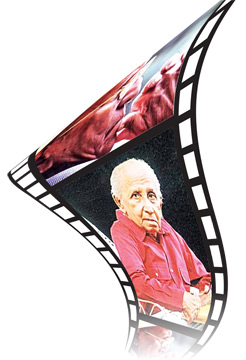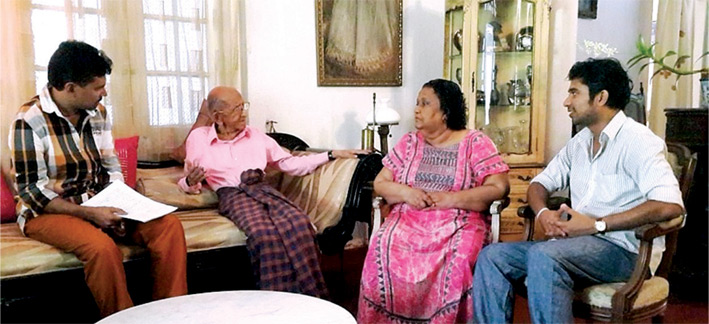|
 ‘Lester by Lester’: ‘Lester by Lester’:
Chartering course to Sinhala readers
By Dilshan Boange
Every screen star ever born owes their parentage to the cinematic
eyes and creative pulse of a person lesser publicly cheered and adored –
the film-maker. The status of the film’s director is one borne with
great dignity and power in the world of art and entertainment. Their
visions for work in the art of the moving image create idols in the form
of actors and actresses who attract public adulation, the ones whose
names endure the test of time get ‘laurelled’ as ‘legends’.
Today in Sri Lanka we cannot talk of cinema, and especially the
cinema history our country has developed over the course of the latter
part of the past century, without focusing on the body of work created
by Dr. Lester James Peries, who now at the age of 95 is the oldest
living film-maker in the world.
He is without doubt, owing to the magnitude of what he offered the
Sri Lankan cinema-goer in terms of both quality and quantity of films, a
celebrity, a star, and one who has clearly ascended to the stature of a
‘living legend’.
The legacy that LJP has produced to the world of cinema during his
long active career is one that few Sri Lankan film-makers can fathom to
parallel, let alone surpass. The story of each of his works, as to how
they got started, from screenplay to film set and the anecdotes and
workings that underlay the complexities of film-making are all
descriptively and captivatingly on record in the book Lester by Lester;
as told to Kumar de Silva.
Arriving towards mid-morning on that warm and sultry Saturday I was
greeted by Kumar de Silva who had planted himself on a cane chair right
at the doorstep to the house of the Peries’s in the hopes of catching a
cooling breeze one may venture to suggest, looking out at the elegant
and homely garden of the residence. “Ah! You’re playing the welcoming
committee today?”
First visitor
Kumar told me to go right in and proceeded to announce to Mrs. Peries
that the first visitor expected had arrived. Although I had met Mrs.
Peries briefly at two literary events in the past, this was my first
interaction of a more social and relaxed setting.
With abounding warmth and sincere amiability Mrs. Peries invited me
to make myself comfortable in the living room of their elegantly ornate
home with its walls decked with works of the famous artist Ivan Peries
who was LJP’s brother.
Between Mrs. Peries, Kumar and I convivial conversation arose
naturally and soon enough the pivotal person arrived – the translator
Mr. Athula Samarakoon who is currently the Head of the Fine Arts
Department of the University of Peradeniya.
|

From L-R : Athula Samarakoon, Dr. Lester James Peries,
Sumitra Peries and Dilshan Boange |
If one may wonder what my involvement is in this scenario, what
validated my presence that morning to a social yet purposive meeting
pertaining to an upcoming publication; it was in having introduced
Athula to Kumar as a potential translator to take on the job since I was
well aware of his knowledge on the subject of film and his capacity to
produce commendable writing in Sinhala which is on account of having
known him as the lecturer who substituted for Dr. Dharmasena Pathiraja
at the Colombo University during my undergrad days when I took the
course unit on film studies in the course of reading for my Bachelor’s
in Arts.
After Athula exchanged warm greetings with all present the first line
of conversation that arose was Athula’s recollection of the interview he
did of Mrs. Peries many years ago. A somewhat surprised Sumithra Peries
then brought back to her memory the interview that was done with her for
a Rupavahini broadcast before she left for Paris as Sri Lanka’s
Ambassador.
As hearty conversation got in gear and a very convivial air set into
the ambience Kumar, the unofficial “foster son” of Lester James and
Sumitra asked us, what we would like for refreshment, “Tea, coffee or a
cool drink?” As Athula and I both felt a cool drink of water would be
the most apt given the climate, Mrs. Peries was quick to add to the
range of choices “We also have thambili!” And no sooner did we hear that
it was settled that we had hit upon the ideal ‘refresher’ to answer the
need of the hour.
Sinhala translation
Over the thirst quenching long cool drink of king coconut we got down
to the matter at hand. The Sinhala translation which was under-way, and
in need of being discussed between the translator and the persons with
moral authority over the subject matter of the book.
Some aspects of translation which take central concern in any project
of translating a book from one language
to another were in need of being clarified by the translator so as to
ensure the final outcome is one that is satisfactory to all parties
concerned.
One of the first things Athula pointed out to Mrs. Peries was that
LJP’s oral narrative presented in the book is very poetic in its
idiomatic approach and descriptions.
“More than half the words he uses in a sentence build an idiomatic
image and turn of phrase,” said the translator who admitted in all
honesty that what he had in his hands was an onerous task! And the
objective of capturing the image and essence of LJP’s tone with diction
that offers more to the Sinhala reader than a mere verbatim translation
of the English book was a point that the translator stressed on.
Mrs. Peries who represented with good authority the interests and
concerns of LJP agreed wholeheartedly that the Sinhala translation
should have its own ‘flavour’ attuned to the Sinhala
readers and their expectations for an enjoyable reading experience.
Many it seems are the concerns that must be balanced out between the
different parties involved before a translation is sent to the printer!
“It’s a matter of balancing between two cultures.” I pitched in to
the flow of dialogue since the question of how each language captures
cultural facets that aren’t a hundred percent translatable came up.
Expressionisms after all are central to capture the essence of a
culture when approaching it from a point of language as opposed to
viewing it in relation to ritualism and mannerisms observed by people.
In certain instances if verbatim translation was applied not only
would the flavour of the language be lost but the translated sentence
would be meaningless.
|

From L-R, Translator Athula Samarakoon, Dr. Lester James
Peries and Dilshan Boange |
The prime example I can think of would be how the English phrase
“Carrying coals to Newcastle” seems if translated word for word into
Sinhala as popping up in a dialogue between two people purportedly in
Sinhala! Or for that matter how would the Sinhala expression “Mona kehel
malakda!” seem if translated to an English text as “What banana flower!”
The ‘passages’, pun intended, in which the translator has to navigate
himself through to deliver a vernacular tone yet maintaining a literary
mould, were not without their bends and slopes.
Expectation
Mrs. Peries pointed out that the expectation on the part of LJP was
not for a book that would read itself out as an academic work but be
accessible to and understood by the lay reader. Athula conceded on the
point of LJP’s concern, he also pointed out a prime objective of the
forthcoming translation.
The integrity of the work as a Sinhala translation, he said will rest
on its ability to represent the mettle of LJP’s approach to addressing
an audience on the subject of film. He said it should not be simplified
in its tonalities to the extent of nearing commonplace colloquialism as
the range for variance between formal speech and colloquialism in the
Sinhala language is far wider than with English.
The ‘grammaticism’ involved is far more complex when it comes to
Sinhala than English was the central factor that had to be kept in
sight. Athula then read out a chapter of what he has already translated
and both Kumar and Mrs. Peries agreed that it had the satisfactory tone
and phrase to it.
Soon enough we were joined by LJP himself who despite his somewhat
delicate state of physical health joined us in the sitting room for
conversation.
It was truly a treat for Athula and myself to listen to LJP’s own
words of how certain film projects posed logistical nightmares the main
example being the children’s film ‘Pinhami’. “When we took the baby
elephant to the sugar cane field, he began eating and eating and we had
no way of getting him out! He had such a good time eating the sugar
cane. He had no intention of taking some for his mother like the script
says!” LJP explained to our great amusement. Hearing it from the master
himself it was obvious that stories are much easier written than made to
film!
Moving image
Sathyajith Ray, the legendary Bengali film-maker had been close
friends with LJP. Upon seeing ‘Golu Hadawatha’ directed by LJP he had
been so enamoured with the film he had confided in the Sri Lankan
maestro of the moving image that he, Ray, was contemplating of doing a
Bengali film with a similar storyline! What would have the Bengali
maestro offered the world of cinema had he pursued that aspiration, one
can now only conjecture.
On a more saddening topic of conversation related to film
preservation and the present state of LJP’s films in celluloid form, it
was revealed that the cinema copy of ‘Ahasin Polowata’ had disintegrated
completely over the course of time!
LJP stressed on how the matter of effective film preservation is a
pressing need of the times in our country and that the film archives
being set up under President Mahinda Rajapaksa is a productive
initiative that will be of great service to the film industry.With over
two hours of conversation time being spent with us, it was clear that
his present state of physical frailty on account of age had not
dispossessed LJP of a sharp and perceptive mind capable of clear
recollection and elucidation.
Athula explained to LJP, before our visit was to conclude, his
approach devised as a translator, so as to do justice to both the
English text and the upcoming Sinhala translation on account of the
idiomatically stylised rich language. The maestro film-maker expressed
his consent to what was proposed and also his faith in the translator’s
ability to achieve a result that will do justice to the original English
text, the subject of the book as well as the future readers of the
upcoming Sinhala translation.
The Sinhala book is set to be released by Samaranyake Publishers in
July and to be formally launched as part of the ‘French Spring Festival
2014’ hosted by the Alliance Francaise de Kotte in collaboration with
the Embassy of France in Sri Lanka. The book will provide much insight
to Sinhala readers of how LJP’s craft and background stories developed.
As we took our leave of the Peries’ that day I felt a tremendous
satisfaction at having been able to be part of a discussion that offered
much food for thought and lessons to note. The fruitfulness of that
day’s discussions will surely manifest in the days ahead.
|

